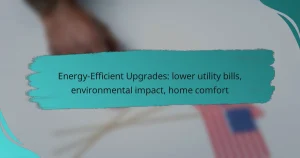Home renovations can transform your living space, enhancing both functionality and aesthetics while potentially increasing property value. This guide explores various types of renovations, including kitchens, bathrooms, and outdoor spaces, helping you understand the best options for your needs and budget. By assessing your specific requirements and local regulations, you can make informed decisions that align with your renovation goals.
Kitchen Overhaul: increased home value, improved functionality, modern aesthetics
A kitchen overhaul is a powerful investment that can elevate your home’s value by improving functionality and modernizing its aesthetics. By upgrading appliances, optimizing layouts, and incorporating contemporary design trends,…
Bathroom Refresh: enhanced comfort, better resale value, updated features
A bathroom refresh can greatly improve comfort and functionality in your home while also boosting its resale value. By upgrading fixtures, enhancing storage, and incorporating modern features, you create a…
Energy-Efficient Upgrades: lower utility bills, environmental impact, home comfort
Energy-efficient upgrades offer a practical solution for homeowners looking to lower utility bills while enhancing comfort and reducing their environmental impact. By implementing improvements such as better insulation, energy-efficient appliances,…
Contemporary Office: innovative workspace, tech integration, bright colors
Contemporary offices are transforming into innovative workspaces that prioritize collaboration, flexibility, and employee engagement. By integrating advanced technologies like smart lighting and virtual collaboration tools, these environments not only enhance…
Shabby Chic Nursery: soft colors, vintage accessories, cozy feel
Creating a Shabby Chic nursery involves a delicate blend of soft colors, vintage accessories, and cozy textiles to craft a warm and inviting environment for your baby. By incorporating muted…
Garage Makeover: organized space, functional storage, aesthetic improvement
A garage makeover can transform a cluttered space into an organized and functional area that enhances your home’s overall aesthetic. By incorporating custom shelving, modular storage, and wall-mounted organizers, you…
Landscape Redesign: curb appeal enhancement, outdoor enjoyment, property value
Landscape redesign plays a crucial role in enhancing curb appeal, outdoor enjoyment, and property value. By incorporating elements like native plants and modern hardscaping, homeowners can create visually appealing and…
Appliance Upgrades: cost-benefit analysis, energy efficiency, brand comparisons
Upgrading appliances can provide significant cost benefits by enhancing energy efficiency and lowering utility bills. While the initial investment may be higher for energy-efficient models, the long-term savings and increased…
Finished Basement: additional living space, rental potential, family enjoyment
A finished basement can greatly expand the living space in your home, transforming unused areas into functional and enjoyable rooms. This versatile space not only caters to family needs, such…
Eco-Friendly Living Room: sustainable materials, natural lighting, green technology
Transforming your living room into an eco-friendly space involves the thoughtful selection of sustainable materials, the strategic use of natural lighting, and the integration of green technology. These elements work…
What are the most popular home renovation types in Australia?
The most popular home renovation types in Australia include kitchens, bathrooms, living rooms, outdoor spaces, and basements. Each type of renovation can significantly enhance both the functionality and aesthetic appeal of a home, often leading to increased property value.
Kitchens
Kitchens are often the heart of a home and a focal point for renovations. Popular updates include modern appliances, new cabinetry, and open-plan designs that improve flow and usability. When renovating a kitchen, consider the layout, storage solutions, and lighting to create a functional space.
Budgeting for a kitchen renovation typically ranges from AUD 15,000 to AUD 50,000, depending on the extent of the changes and materials chosen. Avoid over-customizing, as this can limit future buyer appeal.
Bathrooms
Bathroom renovations can enhance comfort and increase home value. Common upgrades include new fixtures, tiles, and improved ventilation. Focus on maximizing space, especially in smaller bathrooms, by using clever storage solutions and light colors to create an illusion of openness.
The average cost for a bathroom renovation in Australia can range from AUD 10,000 to AUD 30,000. Prioritize quality over quantity in fixtures to ensure longevity and satisfaction.
Living Rooms
Living rooms serve as a gathering space, making them a popular choice for renovations. Enhancements may include new flooring, updated lighting, and modern furnishings. Consider creating a cohesive design that reflects your style while ensuring comfort and functionality.
Renovating a living room can cost anywhere from AUD 5,000 to AUD 20,000, depending on the scope of work. Avoid clutter by choosing a few statement pieces rather than overcrowding the space.
Outdoor Spaces
Outdoor renovations can expand living areas and enhance enjoyment of your property. Popular projects include decks, patios, and landscaping. When planning outdoor renovations, consider factors like climate, maintenance, and how the space will be used.
Costs for outdoor renovations can vary widely, typically ranging from AUD 3,000 to AUD 15,000. Ensure that any structures comply with local council regulations and consider sustainable materials for long-term benefits.
Basements
Basement renovations can transform underutilized spaces into functional areas such as home theaters, guest suites, or recreational rooms. Key considerations include moisture control, insulation, and proper lighting to create a welcoming environment.
Renovating a basement usually costs between AUD 20,000 and AUD 60,000, depending on the complexity of the project. Always check local building codes and regulations before starting, as these can impact your renovation plans.
How to choose the right home renovation type?
Choosing the right home renovation type involves understanding your specific needs, budget, available space, and local regulations. A clear assessment of these factors will help you make informed decisions that align with your goals and constraints.
Assessing your needs
Begin by identifying what you want to achieve with your renovation. Are you looking to enhance functionality, improve aesthetics, or increase property value? Prioritize your needs to focus on the most impactful changes.
Consider the long-term benefits of each renovation type. For example, kitchen upgrades can significantly boost home value, while adding a home office may cater to remote work needs. Make a list of must-haves versus nice-to-haves to guide your project.
Budget considerations
Your budget is a crucial factor in determining the type of renovation you can pursue. Establish a clear budget range that includes materials, labor, and unexpected costs, which can often arise during projects.
For instance, minor renovations like painting or landscaping may cost a few hundred to a few thousand dollars, while major renovations, such as kitchen or bathroom remodels, can range from several thousand to tens of thousands of dollars. Always leave a buffer of about 10-20% for unforeseen expenses.
Space availability
Evaluate the space you have available for renovation. This assessment will influence the type of changes you can realistically implement. Measure dimensions and consider how the new layout will flow with existing spaces.
For example, if you have limited square footage, consider open-concept designs or multifunctional furniture to maximize usability. If space is abundant, you might explore options like adding an extension or a new room.
Local regulations
Familiarize yourself with local building codes and regulations that may affect your renovation. These rules can dictate what types of renovations are permissible, especially for structural changes or additions.
Check with your local government or a licensed contractor to understand necessary permits and inspections. Non-compliance can lead to fines or the need to undo completed work, so it's essential to ensure your plans align with local standards.
What are the costs associated with home renovations?
Home renovation costs can vary widely based on the scope of the project, materials used, and labor expenses. Understanding these costs is crucial for budgeting effectively and avoiding unexpected financial strain.
Average kitchen renovation costs
The average kitchen renovation can range from several thousand to tens of thousands of dollars, depending on the extent of the updates. A minor remodel might cost around $10,000 to $15,000, while a major overhaul could exceed $50,000.
Key factors influencing kitchen renovation costs include cabinetry, countertops, appliances, and labor. Prioritize your needs and consider where you can save, such as opting for stock cabinets instead of custom ones.
Bathroom renovation pricing
Bathroom renovations typically range from $5,000 to $25,000, with upscale remodels potentially reaching $50,000 or more. The price largely depends on the size of the bathroom and the quality of fixtures and finishes.
When planning a bathroom renovation, consider the costs of plumbing, tile, and vanities. Small changes, like updating fixtures or re-grouting tiles, can refresh the space without a significant investment.
Living room updates
Living room renovations can vary from simple cosmetic changes to extensive remodels, with costs ranging from $2,000 to $20,000. Basic updates like painting or new furniture are more affordable, while structural changes can be costly.
Focus on high-impact areas such as flooring, lighting, and wall treatments. Investing in quality furniture or a feature wall can significantly enhance the room's appeal without a complete renovation.
Outdoor renovation expenses
Outdoor renovations can range from $1,000 for basic landscaping to over $50,000 for extensive projects like decks or patios. The scope of work and materials chosen will greatly influence the final cost.
Consider the purpose of your outdoor space when planning renovations. Simple enhancements like planting trees or installing a fire pit can improve aesthetics and functionality without breaking the bank.
What are the benefits of home renovations?
Home renovations offer numerous advantages, including enhanced property value and improved functionality. These upgrades can lead to a more comfortable living environment while also providing a solid return on investment.
Increased property value
One of the primary benefits of home renovations is the potential for increased property value. Upgrades such as kitchen remodels, bathroom renovations, and energy-efficient improvements can significantly boost your home's market appeal.
For instance, a well-executed kitchen remodel can yield a return on investment of around 60-80%. Focus on modernizing fixtures and finishes to attract potential buyers and increase your home's worth.
Improved functionality
Renovations can greatly enhance the functionality of your home, making it more suitable for your lifestyle. This may involve reconfiguring spaces, adding storage solutions, or improving layouts to better meet your needs.
For example, converting an unused basement into a functional living area can provide additional space for family activities or guests. Consider your daily routines and how renovations can streamline your living experience.






